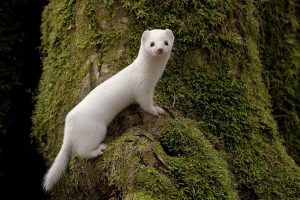| Project duration: | 2016-2019 |
|---|---|
| Project status: | Active |
| Project leader: | Dr hab. D.P.J. Kuijper |
| Project co-investigators: |
Dr. Marcin Churski (IBS PAN) Jakub Bubnicki (IBS PAN) Roman Kozak (IBS PAN) Annelies van Ginkel (University of Groningen, Netherlands) Prof. dr. ir. C. Smit (University of Groningen, Netherlands) |
Research project objectives:
The aim of this project is to study how large carnivores (wolf, Canis lupus) indirectly influence the regeneration of different tree species by modifying the foraging behavior of ungulates (especially red deer, Cervus elaphus) in the Białowieża Primeval Forest in Poland. Previous studies in this area showed that large tree logs on the forest floor, can impede view and escape possibilities and therefore are perceived as risky areas by ungulates. We will test the long-term effects of tree logs on the regeneration of preferred and less preferred tree species inside and outside wolf-core areas. We hypothesize that the combined impact of treelogs and carnivore presence on tree regeneration depends on the palatability of the target tree species: highly preferred species will profit most from the combined protective effects of tree logs and carnivores, while low palatable species will be able to regenerate without these protective effects.
Research project methodology
The study will be conducted in the Polish part of Białowieża Primeval Forest, where five ungulate species(red deer, wild boar, European bison, moose and roe deer) are present with their natural predators (wolf and lynx). We will combine a series of descriptive and experimental field studies to test our hypotheses. We will survey transects inside and outside the centre of wolf territories (wolf core areas) and assess the survival,growth and browsing intensity of naturally established tree saplings and compare the performance of palatable tree species (f.e. Carpinus betulus, Tilia cordata, Acer platanoides) and less palatable species (f.e. Pinus sylvestris, Picea abies, Alnus glutinosa) and determine their association with tree logs. Separately, by taking detailed measurements (as above) on plots at different distances from tree logs we will study at what distance these facilitating effects on tree regenerations can be observed.
In addition, we will perform a large-scale experiment in which we plant tree saplings from eight different species, ranging from highly preferred species to less preferred species by red deer. Experimental plots will be established at different distances from the centre of wolf core areas. On half of the plots we will add ourselves an impediment that blocks the view and creates a physical barrier to mimick the effect of a tree log. Detailed tree measurements will be done and camera traps will provide data on visitation rate of ungulate species and their behavior. The experiment is aimed to test for the interactive effects of tree logs and wolf presence on the browsing intensity and growth of different tree species.
We planned two pilot studies to test whether the studied predation risk factors, operate in other forest systems in Europe. In intensively managed (forestry, hunting) forest systems in Sweden, we test whether wolf presence significantly reduces ungulate browsing intensity of forest plantations. In the Netherlands, we test whether tree logs are still perceived as a risk factor and affect red deer browsing intensity in predator free forest.

